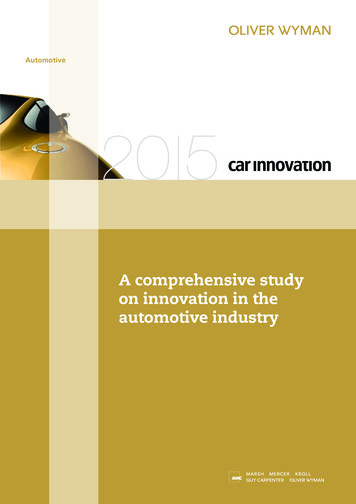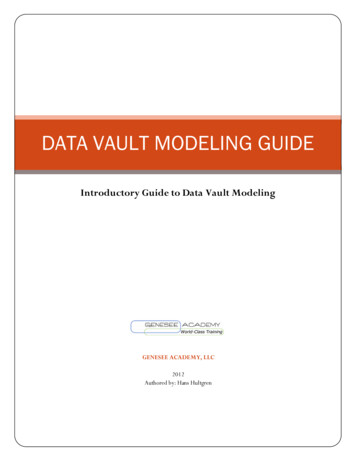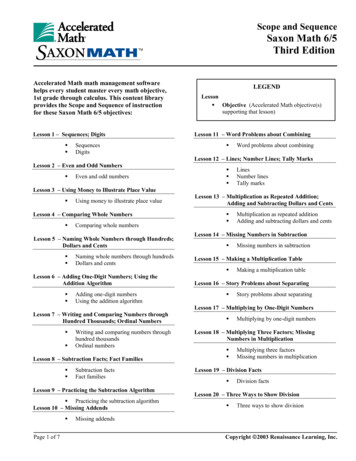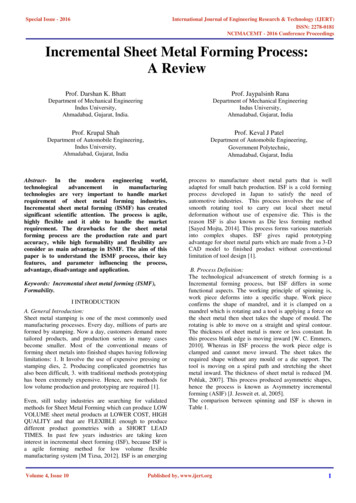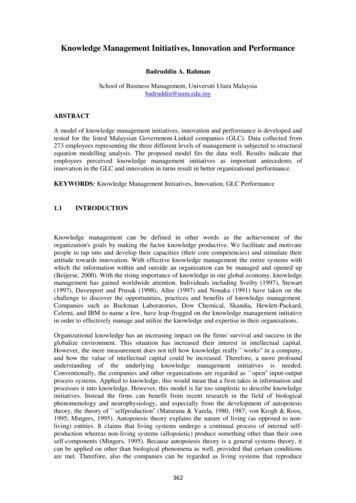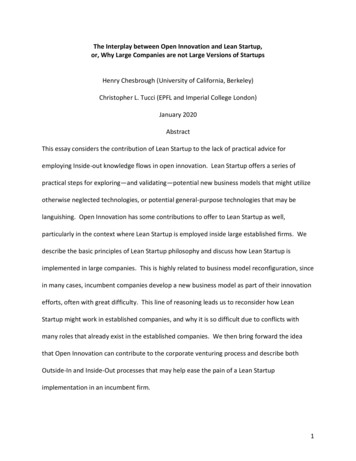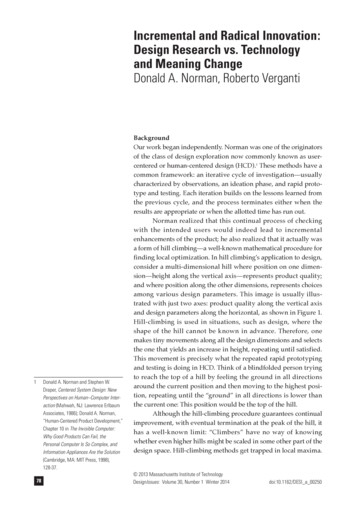
Transcription
Incremental and Radical Innovation:Design Research vs. Technologyand Meaning ChangeDonald A. Norman, Roberto Verganti1Donald A. Norman and Stephen W.Draper, Centered System Design: NewPerspectives on Human–Computer Interaction (Mahwah, NJ: Lawrence ErlbaumAssociates, 1986); Donald A. Norman,“Human-Centered Product Development,”Chapter 10 in The Invisible Computer:Why Good Products Can Fail, thePersonal Computer Is So Complex, andInformation Appliances Are the Solution(Cambridge, MA: MIT Press, 1998),128-37.78BackgroundOur work began independently. Norman was one of the originatorsof the class of design exploration now commonly known as usercentered or human-centered design (HCD).1 These methods have acommon framework: an iterative cycle of investigation—usuallycharacterized by observations, an ideation phase, and rapid prototype and testing. Each iteration builds on the lessons learned fromthe previous cycle, and the process terminates either when theresults are appropriate or when the allotted time has run out.Norman realized that this continual process of checkingwith the intended users would indeed lead to incrementalenhancements of the product; he also realized that it actually wasa form of hill climbing—a well-known mathematical procedure forfinding local optimization. In hill climbing’s application to design,consider a multi-dimensional hill where position on one dimension—height along the vertical axis—represents product quality;and where position along the other dimensions, represents choicesamong various design parameters. This image is usually illustrated with just two axes: product quality along the vertical axisand design parameters along the horizontal, as shown in Figure 1.Hill-climbing is used in situations, such as design, where theshape of the hill cannot be known in advance. Therefore, onemakes tiny movements along all the design dimensions and selectsthe one that yields an increase in height, repeating until satisfied.This movement is precisely what the repeated rapid prototypingand testing is doing in HCD. Think of a blindfolded person tryingto reach the top of a hill by feeling the ground in all directionsaround the current position and then moving to the highest position, repeating until the “ground” in all directions is lower thanthe current one: This position would be the top of the hill.Although the hill-climbing procedure guarantees continualimprovement, with eventual termination at the peak of the hill, ithas a well-known limit: “Climbers” have no way of knowingwhether even higher hills might be scaled in some other part of thedesign space. Hill-climbing methods get trapped in local maxima. 2013 Massachusetts Institute of TechnologyDesignIssues: Volume 30, Number 1 Winter 2014doi:10.1162/DESI a 00250
Figure 1The hill-climbing paradigm applied toincremental and radical innovation.A given product might start off at “A.”Through Human-Centered Design and DesignResearch (HCD & DR), the product undergoesa series of incremental innovations, eventually bringing it to its maximum quality for thispart of the design space, point “B.” To moveto a different hill, one with a higher potential,requires radical innovation, and this comesabout through either technology or meaningchange, leading to point “C” on a larger hill.Note that the initial outcome is often inferiorto that previously reached (“B”), and so HCDand DR are required to make the necessaryincremental innovations to reach maximumpotential. To make matters more complex,when the product is at point “C,” there is noway of knowing if indeed there is a superiorlevel (“D”) or if this is an inferior spot in thedesign space.23456Donald A. Norman, “Science andDesign,” (paper presented at the annualmeeting of the International Associationof Societies of Design Research, Seoul,S. Korea, October 18-22, 2009).Donald A. Norman, “The Research–Practice Gulf,” (paper presented at theIIT Institute of Design, Design ResearchConference, Chicago, IL, May 10-12,2010).Donald A. Norman, “Technology First,Needs Last: The Research–Product Gulf,”Interactions 17, no. 2 (2010): 38–42.Roberto Verganti, Design-Driven Innovation: Changing the Rules of Competitionby Radically Innovating What ThingsMean (Boston: Harvard BusinessPress, 2009).Roberto Verganti, “User-CenteredInnovation Is Not Sustainable,”Harvard Business Review Blogs, ation is no.html (accessed March19, 2010).Incremental innovation tries to reach the highest point on the current hill. Radical innovation seeks the highest hill. The implicationfor design is clear: Because HCD is a form of hill-climbing, it isonly suited for incremental innovation.Norman was bothered by his analysis and tried to findexamples that refuted this conclusion; he failed. Every radicalinnovation he investigated was done without design research,without careful analysis of a person’s or even a society’s needs. Thelist of such innovations starts out long before design researchexisted, with such technologies as indoor plumbing, electric lighting in homes, the automobile and airplane, radio and television.But even today, radical innovations, such as Facebook’s and Twitter’s development of social networks, have come about simplybecause their inventors thought they were interesting things to try.Norman was unable to find any example of radical innovation thatresulted from the HCD process. HCD, he stated, was only suitablefor incremental innovation. Norman argued that radical innovations were driven by technology changes, without any designresearch or formal analysis of needs. Once the radical innovationhad been developed, however, HCD was invaluable as a way ofimproving the product and enhancing its appeal—good examplesbeing the way that Google, Facebook, and Twitter have modifiedthemselves since their initial introduction, or how automobilemanufacturers slowly and continuously modify their offerings.Norman presented his results at the IASDR (InternationalAssociation of Societies of Design Research) conference in Seoul,2at IIT’s (Illinois Institute of Technology) Design Research Conference, DRC 2010, 3 and in the ACM (Association for ComputingMachiner y) magazine, Interactions. 4 During t his process,Norman came across Verganti’s book, Design-Driven Innovation, 5and his Harvard Business School blog,6 which made very similarDesignIssues: Volume 30, Number 1 Winter 201479
arguments to what Norman was proposing. That these two lines ofthought articulated separately by Norman and Verganti should becombined seemed clear—a task undertaken by Norman in his DRC2010 conference presentation.Verganti, a scholar of innovation management, had come todesign after conducting research on the management of technological innovation. In search of a definition of design that could clarify and distinguish from other drivers (e.g., technology or market)design’s contribution to innovation, he rooted his investigation inthe definition of design as “making sense of things,” as describedby Klaus Krippendorf and John Heskett (also in personal communication with Norman):The etymology of design goes back to the Latin de signare and means making something, distinguishingit by a sign, giving it significance, designating its relationto other things, owners, users, or gods. Based on thisoriginal meaning, one could say: Design is making sense(of things).7Design: The deliberate and reasoned shaping and makingof our environment in ways that satisfy our needs and givemeaning to our lives.87Klaus Krippendorff, “On the EssentialContexts of Artifacts or on the Proposition that ‘Design is Making Sense (ofThings),’” Design Issues 5, no. 2 (1989):9–38.John Heskett, Toothpicks & Logos:Design in Everyday Life (New York:Oxford University Press, 2002).Donald A. Norman and Roberto Verganti,“Innovation and Design Research,”(lecture presented at the DesigningPleasurable Products and InterfacesConference, Milan, June 23-24, 2011).8980Verganti’s views were similar to those of Norman. The two agreedregarding the importance of HCD for incremental innovation andits weakness in radical innovation. They agreed regarding theimportance of technology change in driving radical innovation.But Verganti went one step further: He demonstrated that radicalinnovation could also come about through changes in meaning.Once the two discovered one another’s works, they collaborated ona talk for the “Designing Pleasurable Products and Interactions”conference in Milan in 20119 —much to the dismay of audiencemembers, who expected the two to battle one another about theimportance of human-centered design. This paper grew out ofthat talk.Our observations convince us that the need has emerged fora better understanding of design research and design innovationand how they are linked. In our discussion, we consider design asthe process of “making sense of things.” Hence, our questions turnmore precisely into the following ones: What type of research isconducted on the meaning of things? And to what types of innovative output can this research lead? How are the two concepts,design research and design innovation, related?In answering these questions, our purpose is not to providespecific tools and steps, which are already well developed in otherstudies, and whose description would require a larger space thanwhat can be done within an article. (For these tools we thereforerefer readers to the existing theories and publications.) Rather, weDesignIssues: Volume 30, Number 1 Winter 2014
answer the questions posed by addressing the fundamental decision any innovation player has to make before moving into the useof specific tools: What general approach should be used to addressan innovation challenge? What set of theories, processes, and toolsshould be considered?The purpose of this paper is to provide a theoretical framework for distinguishing between the procedures of incrementaland radical innovation and to address the fundamental activitiesof innovation. For this purpose, we provide three different ways oftreating innovation: as the attempt to find the maxima in a hillyterrain whose topology is unknown and novel, as movements inthe product space defined by the two axes of “technology change”and “meaning change,” and as a design research quadrangle basedon Stokes’s two dimensions of “advances in understanding” and“consideration of practicality.”We start the paper by suggesting that radical product innovation is driven by either advances in technology or a deliberatechange in the meaning of the product, rather than being driven bythe human-centered design philosophy widely used in productdesign. In our examination of both existing products and the literature on innovation, we were unable to find any contrary evidence.Incremental innovation was performed as a result of a deliberatedesign research strategy or through a series of mutual adaptationsby the product developers and the use community to bring the twointo better alignment. In contrast, radical product introductionscould always be traced to the introduction of a new technologythat provided new affordances to the designers or to a new meaning assigned to the product and its uses, allowing for radicalchanges using existing technologies. Of course, some radicalchange incorporated both new technologies and meaning changes.Note that our observations and interpretations are neutralwith respect to the ongoing debate between the relative importanceof technical or social determinism. One could interpret technologydriven radical innovation as an example of technological determinism; meaning-driven radical innovation as an example of socialdeterminism; and human-centered incremental innovation aseither technological or social determinism, depending on the theoretical biases involved. We subscribe to the belief that factorsrelated to both technical and social determinism are always in play.Types of Design ResearchThe concept of research takes two different forms in design. Oneperspective sees research as exploration and experimentation thatleads to the advancement of knowledge, the development of theories, and the application of theories. This perspective has been thesubject of reflections, definitions, and effective classifications bydesign theorists. For example, Frayling’s well-known, three-partclassification of design research includes research into design,DesignIssues: Volume 30, Number 1 Winter 201481
research through design, and research for design.10 See also Cross,11Friedman,12 and Feast and Melles.13 These definitions all share anepistemological base aimed at advancing knowledge.The other perspective sees research as any activity of collection and analysis of data for a better understanding of a topic(which therefore includes the research a student at an elementaryschool conducts to write a paper on what tigers eat). This perspective is used by practitioners to indicate their research activities. Forexample, they might use ethnographic research or observations onpeople’s activities as a means to understand user needs, productresearch as a means to identify possible solutions, market researchas shedding light on the kinds of products people would buy andtheir price sensitivity, and usability research as indicating theinteraction between people and products. In this second perspective, design research focuses on how to improve both products andsales. In this paper we concentrate on this second perspective ofdesign research.10 Christopher Frayling, “Research in Artand Design,” Royal College of ArtResearch Papers 1, no. 1 (1993): 1–5.11 Nigel Cross, “Design Research: ADisciplined Conversation,” Design Issues15, no. 2 (1999): 5-10.12 Ken Friedman, “Theory Construction inDesign Research: Criteria, Approachesand Methods,” Design Studies 24, no. 6(2003): 507–22.13 Luke Feast and Gavin Melles, “Epistemological Positions in Design Research: ABrief Review of the Literature” (paperpresented at Connected 2010: 2nd International Conference on Design Education, University of South Wales, Sidney,Australia, June 28-July 1, 2010).14 Kristina B. Dahlin and Dean M. Behrens,“When Is an Invention Really Radical?Defining and Measuring TechnologicalRadicalness,” Research Policy 34 (2005):717–37.82Two Types of Innovation: Incremental and RadicalWe can identify many kinds of innovation, and classificationmight vary according to the object of innovation. For example, categories include innovation of socio-cultural systems, of ecosystems, of business models, of products, of services, of processes, oforganizations, of institutional arrangements, etc. Classificationsmight also vary according to the drivers of innovation (technologies, markets, design, users, etc.), or to the intensity of innovation.In this paper we focus on two categories of innovation for productsor services: Incremental innovation: improvements within a givenframe of solutions (i.e., “doing better what we alreadydo”); and Radical innovation: a change of frame (i.e., “doing whatwe did not do before”).The major difference between the two is whether the innovation isperceived as a continuous modification of previously acceptedpractices or whether it is new, unique, and discontinuous. Dahlinand Behrens suggest three criteria for identifying an innovation asradical:14 Criterion 1: The invention must be novel: It needs to bedissimilar from prior inventions. Criterion 2: The invention must be unique: It needs tobe dissimilar from current inventions. Criterion 3: The invention must be adopted: It needs toinfluence the content of future inventions.DesignIssues: Volume 30, Number 1 Winter 2014
15 Rosanna Garcia and Roger Calantone, “ACritical Look at Technological InnovationTypology and Innovativeness,” The Journal of Product Innovation Management19, no. 2 (2002): 110–32.16 William J. Abernathy and Kim B. Clark,“Innovation: Mapping the Winds ofCreative Destruction,” Research Policy 14(1985): 3–22; Michael L. Tushman andPhilip Anderson, “Technological Discontinuities and Organizational Environments,” Administrative Science Quarterly31, no. 3 (1986): 439–65; James M.Utterback, Mastering the Dynamics ofInnovation (Boston: Harvard BusinessSchool Press, 1994); Clayton M. Christensen, The Innovator’s Dilemma: WhenNew Technologies Cause Great Firms toFail (Boston: Harvard Business SchoolPress, 1997); Henry Chesbrough, “Assembling the Elephant: A Review of EmpiricalStudies on the Impact of TechnicalChange upon Incumbent Firms,” inComparative Studies of TechnologicalEvolution, Robert A. Burgleman andHenry Chesbrough, ed. (Oxford: Elsevier,2001), 1–36.17 Birgitta Sandberg, Managing andMarketing Radical Innovations (NewYork: Routledge, 2011).18 Bruce Nussbaum, “Get Creative: How toBuild Effective Companies,” BloombergBusiness Week, www.businessweek.com/magazine/content/05 31/b3945401.htm (accessed August 1, 2012).19 Bill Buxton, “Multi-Touch Systemsthat I Have Known and Loved,” d March 11, 2012).The first two criteria define radicalness; the third, success.Although Criteria 1 and 2 can occur at any time, Criterion 3 onlyoccurs if the sociological, market, and cultural forces are in appropriate alignment. Here is where social determinism plays a majorrole. The correct idea at the wrong time will fail. Examples areApple’s introduction of the QuickTake digital camera and theNewton personal digital assistant in the early 1990s: Despite fulfilling Criteria 1 and 2, both failed in the marketplace, thus failingat Criterion 3. Although the reasons for the failures are complex,Norman, who was an Apple executive at the time, believes thesefailures would make wonderful case histories for believers insocial determinism.Much of the writing on innovation in the design and management communities focuses on radical innovation. It is oftencharacterized as disruptive or competence destroying, or as breakthrough, with all these labels sharing the same concept that radicalinnovation implies a discontinuity with the past.15 Radical innovation has been the center of attention of innovation studies for anumber of decades now.16 It is taught in design and businessschools, and has recently been advocated by people discussinginnovation and “design thinking.” Although radical innovation iswhat everyone wants given its significant potential to differentiate,successful radical innovation is surprisingly rare, and mostattempts at it fail.17 In fact, Larry Keeley, President of the DoblinGroup, estimates the failure rate to be 96%.18 Successful radicalinnovation occurs infrequently in any particular area—perhapsonce every five to ten years.Most radical innovations take considerable time to becomeaccepted (i.e., to fulfill Dahlin and Behrens’s third criterion). Moreover, a completely novel innovation is impossible: All ideas havepredecessors and are always based on previous work—sometimesthrough refinement, sometimes through a novel combination ofseveral pre-existing ideas. As Apple’s introduction of gesturebased cell phones illustrates, ideas do not spring out of thin air.Apple’s development of multi-touch interfaces and their associatedgestures to control hand-held and desktop systems is one oftoday’s radical innovations. However, Apple did not invent eithermulti-touch interfaces or gestural control. Multi-touch systems hadbeen in computer and design laboratories for more than 20 years,and gestures also had a long history. Moreover, several other companies had products on the market using multi-touch before Appledid.19 Although Apple’s ideas were not radical to the scientific community, they did come as a major shift in the world of productsand how people interact with them and give meaning to them.Edison’s development of the electric light bulb was similar,resulting in a radical, major revolution in home and business.However, Edison did not invent the light bulb; he improved theDesignIssues: Volume 30, Number 1 Winter 201483
existing bulbs by extending bulb life and, equally important, herecognized the importance of providing all the necessary infrastructures. Edison brought into view all the system requirementsof generation plants, distribution systems, and even indoor wiringand sockets to hold the bulbs. Thus, his efforts revolutionized theproduct space and the living and working patterns of householdsand businesses.Incremental product innovation refers to the small changesin a product that help to improve its performance, lower its costs,and enhance its desirability, or simply result in a new modelrelease. Most successful products undergo continual incrementalinnovation, intended to lower their costs and enhance effectiveness. This dominant form of innovation is not as exciting as radicalinnovation, but it is just as important. Radical innovations seldomlive up to their potential when they are first introduced. At first,they are often difficult to use, expensive, and limited in capability.Incremental innovations, meanwhile, are necessary to transformthe radical idea into a form that is acceptable to the consumers whofollow the early adopters. The bottom line is that both forms ofinnovation are necessary. Radical innovation brings new domainsand new paradigms, and it creates a potential for major changes.Incremental innovation is how the value of that potential is captured. Without radical innovation, incremental innovation reachesa limit. Without incremental innovation, the potential enabled byradical change is not captured.Technology and Meaning-Driven InnovationHaving introduced some basic concepts of design, research, andinnovation, we can now connect these concepts. We start by mapping the relationships between technology, meaning, and innovation—both incremental and radical. We examine how the twodrivers of innovation, technology change and meaning change,combine to track innovation. And we illustrate the movement ofproducts in the space defined by the two dimensions of technology and meaning for two different domains: video game consolesand watches.Video GamesFigure 2 shows how the two independent dimensions of technology change and meaning change track innovation. Early commercial video games were deployed on specialized game consoles andhome computers. In this example, we focus only on specializedconsoles. Our story starts after the successful introduction of gameconsoles for the home, soon dominated by three major players:Sony, with its Play Station; Microsoft, with its Xbox; and Nintendo,with its GameCube. Playing with a game console provided theopportunity to enter into a new, virtual world—one to whichentrance was a privilege granted only to those who were adept.84DesignIssues: Volume 30, Number 1 Winter 2014
Figure 2Viewing innovation in Video Game Consolesalong the axes of Technology and Meaningchange. The early games were played bysmall numbers of people at a time clusteredaround a game console. The graphics werecrude. Sony and Microsoft followed the technology changes to introduce powerful processors with dramatically enhanced graphics,causing them to dominate the industry. Then,as high-speed internet became possible,they migrated to multi-player games, whereup to a million people could be playing thesame game even though located all acrossthe world. Nintendo leveraged new sensortechnology—accelerometers and infraredimaging—to change the meaning from gamesfor experts to games for everyone, controlledby whole body movements. This revolutionized the video game market. Eventually bothSony and Microsoft were forced to followalong, with Microsoft’s Kinect being the mostsuccessful.The user interface required expertise, which took considerabletime and practice to acquire. The purpose (meaning) was to allowgamers to enter a virtual world in which they would have neverlived otherwise (e.g., a car racing track, a mythical battleground, ora complex maze of paths fraught with dangers, magical objects,and spells). Because reviewers and players of the games allexpressed a desire for even better graphics and faster responsetimes, product innovation was directed toward the creation offaster processors and higher quality graphics.When technical advances in computer chips allowed themanufacturers to provide the requisite computer power, the hugeexpense of providing this technology led to a technological battlefor supremacy between the two largest companies, Microsoft andSony. The introductions of the Sony PlayStation and the MicrosoftXbox represented a radical innovation in technology that was sufficiently powerful to make possible an entirely new collection ofgames and to enable these two companies to dominate the marketfor video game consoles. This developmental path is illustrated inFigure 2 by the movement of the early games in the lower left-handcorner upward along the technology change dimension, where thechange was the development of faster processors and better displays. Nintendo, meanwhile, decided to follow a different path.A related change was the introduction of the capacity formassive numbers of gamers to play simultaneously, connected viathe Internet; these genres are known as Massively MultiplayerOnline Games (MMOLG) and Massively Multiplayer OnlineRole-Playing Games (MMORPG). The games, which attractedhuge numbers of players, continued even when an individualplayer logged off the system, which constituted a meaning changeshown by the shift to the right in Figure 2. Although multipleDesignIssues: Volume 30, Number 1 Winter 201485
player games had already existed, this shift to massive numbers ofsimultaneous players (up to hundreds of thousands of them) constituted a major change in the nature of electronic game playing.Nintendo declined to engage in the battle along the technology dimension but instead focused on the meaning dimension,developing games that were more playable and enjoyable for lessexpert players. Nintendo took advantage of the arrival of inexpensive sensors, both for acceleration and infra-red imaging, and usedthese simple, inexpensive technologies to launch a major meaningchange: games for everyone. With the introduction of the NintendoWii, console games opened up outside the normal, small nichesegment of skilled experts and let the entire family play sports,exercise, and interact with one another without requiring expertskills. The Wii redefined the playing field by combining a simpletechnology shift with a massive meaning shift. Sony and Microsoftstruggled to catch up. A few years later, Microsoft responded withits technology advance, the Kinect, which allows complete controlof the game environment through body movement and gestures,dispensing with the need for the hand-held wands required byNintendo’s Wii.Interestingly, the back-story to Nintendo’s success inredefining the meaning of the video game is that the othermajor video console companies rejected the technology that madethe new meaning possible. They were so focused on their marketof skilled, expert players that they dismissed the sensors as tooprimitive and irrelevant.The success of the Nintendo Wii relied on the clever application of MEMS (MicroElectroMechanical Systems) accelerometersand infrared sensors. These components allow the console to sensethe speed and orientation of the controller, thereby creating a completely new experience for game players who, for example, canserve tennis balls by moving their arms and body to mimic thereal serve of a tennis player. Before the launch of the Wii, MEMSaccelerometers were already known to all manufacturers of gameconsoles, but Microsoft and Sony disregarded their potentialbecause the devices were not helpful in targeting existing userneeds. Their design research showed that the niche of expert gamers wanted more sophisticated virtual realities, so Microsoft andSony invested significant resources to develop even more powerfulprocessors. Nintendo, meanwhile, challenged the existing meaningof game consoles and produced a breakthrough experience—frompassive immersion in a virtual world into active, physical engagement in the “real” world. It didn’t matter that Wii used inferiorprocessors and relatively low-quality graphics. It (the Wii) completely changed the dynamics of the game, attracting a large audience that consisted not only of expert gamers, but also of people ofall ages who did not consider themselves game players.86DesignIssues: Volume 30, Number 1 Winter 2014
Figure 3The dynamics of innovation in thewatch industry. Watches were thoughtof as jewelry, purchased in the jewelry storeand passed along the family to sons anddaughters. A technology change took placewhen electronic circuits made it possible toforgo the complex, hand-made mechanicalassembly of watches. The first attemptsto reproduce watches as jewelry, butusing electronics, did not succeed. ThenJapanese manufacturers redefined thewatch as an instrument for telling time:relatively inexpensive but very accurateand with numerous subsidiary functions.This moved the center for the industry fromSwitzerland to Japan. Swatch, however,brought watchmaking back to Switzerlandby redefining the watch as a fashion accessory. Today, luxury Swiss watchmakers arebringing back the expensive hand-madewatch, but defining it as a status symbol.20 Amy Glasmeier, “Technological Discontinuities and Flexible Production Networks:The Case of Switzerland and the WorldWatch Industry,” Research Policy 20, no.5 (1991): 469–85.Now that this meaning has become dominant, competitors areinvesting in the same direction. The Kinect by Microsoft, for example, enables even more advanced active play through gesture recognition. The evolution of innovation has again turned back to thetechnology dimension, whereas the meaning has remainedunchanged. Figure 2 provides a necessarily simplified view of theprogress of video game consoles, moving upward through changesin technology and rightward through changes in meaning.WatchesBefore the advent of the electronic watch in the 1970s,
and Meaning Change Donald A. Norman, Roberto Verganti Background Our work began independently. Norman was one of the originators of the class of design exploration now commonly known as user-centered or human-centered design (HCD).1 These methods have a comm


